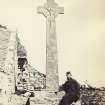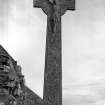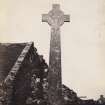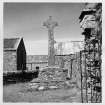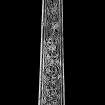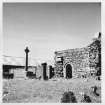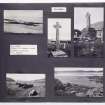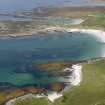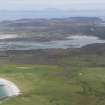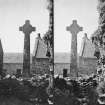Oronsay, Great Cross
Cross (Medieval), Cross Base (Medieval)
Site Name Oronsay, Great Cross
Classification Cross (Medieval), Cross Base (Medieval)
Canmore ID 219939
Site Number NR38NW 9
NGR NR 34942 88922
Datum OSGB36 - NGR
Permalink http://canmore.org.uk/site/219939
- Council Argyll And Bute
- Parish Colonsay And Oronsay
- Former Region Strathclyde
- Former District Argyll And Bute
- Former County Argyll
External Reference (20 July 1971)
1510. Disc-type. Central boss. Carving of Crucifixion with
inscription on W. face of stem, foliage on E. 4 stepped base.
Groome.
Argyll C.C. 'List'
Pennant 'Tour 1772' Vol. I p. 272. (ill.)
Grieve 'Colonsay and Oronsay' Vol. I. p. 373 (ill.)
Muir 'Characteristics' p. 105.
Ecc. Arch. Vol. 1, p. 22, Vol. III, p. 381 (ill.)
P.S.A.S. XV, p.116 (ill.)
Situated to S.W. of Baptistery. Erected in memory of Prior
Colin (d. 1510). Scheduled monmument.
Information from Historic Scotland, 20 July 1971
Field Visit (June 1977)
THE ORONSAY CROSS. Free-standing cross fixed in its original socket-stone (infra) upon a three-tiered rubble-built pedestal 2·7 m square over all by 1·3 m in height. The cross is 3·67 m in height and the shaft tapers from 0·52 m by 0·12 m at the base to 0· 33 m by 0·10 m below the disc-head, which has a diameter of 0·69 m. The span is 1·02 m, and whereas the sidearms are straight-sided, the top arm tapers in width, and terminates above the edge-moulding in a small stepped finial.
The w face is bordered by continuous nail-head ornament between two roll-mouldings, and is dominated by the figure of the Crucified Saviour, in unusually high relief, which fills the disc-head and the upper part of the shaft. The figure is suspended from a rood of cross-raguly type, the feet being crossed and the head slightly inclined towards the left. The spaces in the cross-head and arms are filled by interlace in varying patterns, while the lower part of the figure is flanked by plant-stems emerging from the series of five intertwined foliaceous roundels that occupies the greater part of the shaft and springs at the foot from the tails of a griffin and another beast. Below these creatures is a triquetra knot, and then an inscription and a panel of plait work containing interlocked circles. The inscription, in Lombardic capitals reads:
+ HEC EST CR/UX COUNI F/ILLI CRISTI/NI M(EIC)DUFACI
'This is the cross of Colinus (Malcolm, Gille-Coluim), son of Cristinus MacDuffie'.
The border of the E face comprises a bead-moulding between two roll-mouldings. At the foot of the shaft is a foliated cross, and then two opposed beasts whose tails are linked to intertwined plant-stems forming one incomplete and seven complete roundels. The cross-head is filled by a circular foliated pattern whose centre is plaited round a small pellet and incorporates a continuous ring, while straight stems with pairs of inturned leaves extend into the arms and the upperpart of the shaft.
The socket-stone measures 0·96 m by 0·92 m by 0·12 m in thickness, and its edges are bevelled. At the SE angle is a worn dial or 'mass-clock', comprising an incised 0·28 m circle divided by rays into twenty-four segments; two opposed rays, to N and s, are marked by short transverse strokes. A fragment of the metal gnomon remains in situ at the bottom of the central socket. The following inscription in Lombardic capitals is carved at the foot of the w face of the cross:
+ MAELSEACHL[AI]ND SAER/ [OCUIN]N FECIT IST[AM C]RUCE[M]
'Mael-Sechlainn Ó Cuinn, mason, made this cross'.
Colinus or Malcolm MacDuffie was chief of his clan in the last quarter of the 15th century, and Mael-Sechlainn Ó Cuinn was a mason, trained in the Iona school, and probably identical with the man of the same name who rebuilt the cloister at Oronsay Priory soon after 1500 (p. 243). (Steer and Bannerman, Monumental Sculpture. inscription no. 32, pp. 35- 6 and pl. 13; Pennant, Tour (1772),2, pI. xix; SSS. 2,pIs. xxxviii- ix; Loder, Colonsay, pl. xxxii). Iona school, late 15th century.





















